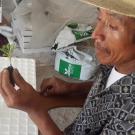Technologies for Horticultural Development fact sheet
Vegetable grafting increases yield, business opportunities
In many tropical countries, the production of vegetables such as tomato can be dramatically reduced by diseases in the soil, impacting the livelihoods of rural families. One of the biggest such problems affecting tomatoes in the tropics is bacterial wilt (Ralstonia solanacearum). Grafting is a proven technology being increasingly adopted worldwide to reduce the risk of soilborne diseases.
How vegetable grafting works
Grafting begins with two types of seedlings that are cut and then physically joined together to grow into one plant. The two parts are:
- the scion, the part of the plant above the ground, which is chosen based on fruit quality for the market
- the rootstock, below ground, which is chosen for its ability to resist soilborne diseases
Immediately after the seedlings are grafted together, plants are placed in a grafting chamber for about one week with high humidity and reduced light intensity for the graft union to heal. The grafted seedlings are further “hardened” in a screenhouse to prepare for transplanting in the field. Depending on growing conditions, the grafting process typically takes about 30-33 days.
Benefits
- Grafted plants can reduce the incidence of plant disease, thus increasing potential yields.
- With reduced plant disease pressures, farmers can reduce their use of pesticides and may be more likely to be able to grow organically.
- Entrepreneurs can specialize in the production of grafted vegetable seedlings, earning income while selling improved seedlings to farmers.
Basic costs to implement
- Potting mix and trays for seedlings
- Clean blade, gloves and plastic for grafting
- Screenhouse
- Grafting chamber
- Labor to graft and care for seedlings
These costs are subject to local variation. Identifying sources of appropriate rootstock and scion is a critical activity
What’s next? Scaling up
Education: Train farmers and extension workers through field trials and demonstration plots. Work with input supplier able to produce the needed plants.
Adoption: Work with non-governmental organizations and extension for promotion and awareness.
Investment: Identify partners and entrepreneurs to establish grafting facilities and distribution channels to deliver plants safely to farmers. Ongoing local research to monitor disease pressures and resistant varieties

